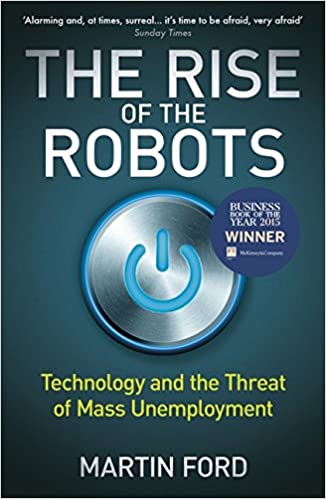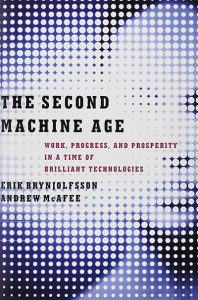
Optimist or pessimist?
We stand on the edge of a technological revolution which is proceeding at an exponential pace and which will impact and alter our work and indeed our way of life in ways we can hardly imagine. The paradox of technological advance and of artificial intelligence is well recognized. Do these developments enhance human well-being and welfare to the benefit of all or is the threat posed to employment so dramatic that the traditional responses of education, reskilling and training will be insufficient to protect us? Some commentators refer to the present period of technological change as ‘the fourth industrial revolution.’ The first represented the move to mechanisation, the second, the introduction of electrical power, the third, digitisation and automation. The change we are now experience is one of exponential speed in processing, the impact of connectivity and access to knowledge that is transformational.
In The Rise of the Robots, Martin Ford essentially argues we are ill-equipped and poorly prepared to face the onslaught heading our way. His two main arguments proceed as follows. First, a change in the types of job which will be affected. The advance of digitisation has alerted society to the possibilities of automating routine processes – hence the advent of robotic methods in production replacing the traditional methods of assembly-line production in, for example, the car industry. This is a familiar story and the usual response is to educate, train and reskill. Ford argues that the problem now is that “the machines are coming for the high-wage, high-skill jobs as well” (page 27). Higher education and knowledge skills which traditionally attracted a premium will no longer protect the worker, so much so, he argues that “the ongoing race between technology and education may well be approaching the endgame” (page 124). Indeed, many professions will find that increasingly capable machines will take on many of the tasks previously seen as exclusive to certain professions such as the law. This is then linked to his second argument, that the ability to replicate and scale machine intelligence will “create winner-take-all scenarios’ with ‘dramatic implications for both the economy and society” (page 82). One example here would be the dominance of a very small number of book distribution platforms effectively eliminating all competition. To return to the example of the law, it is not that the high-street lawyer has digitised conveyancing documents; rather it is the speed and extent of access of processing power that can identify cases and precedents in an instant previously requiring hours in a legal library.
Martin Ford, then, is a pessimist. He understands and appreciates that technological advance has largely driven a more prosperous society. However, on this occasion, he thinks it will be different.
Erik Brynjolfsson and Andrew McAfee are optimists. In The Second Machine Age they do not deny the challenges but establish a framework that argues that “the transformations brought about by digital technology will be profoundly beneficial ones” (page 9), adding that “innovation is also the most important force that makes our society wealthier” (page 72) and “technological progress typically helps even the poorest people around the world” (page 168). They recognise the challenge to employment but remain convinced that “acquiring an excellent education is the best way to not be left behind as technology races ahead” (page 199). Brynjolfsson and McAffee agree with Ford that there are few jobs which will be left untouched by the scaling of digital power. However, they have more confidence in the innovative elements of the human person and human adaptability and flexibility which will enable humanity to seize the opportunities. Importantly, they also point out that despite the rhetoric “digital labour is still far from a complete substitute for human labour. Robots and computers, as powerful and capable as they are, are not about to take all of our jobs” (page 206). They argue that the best way to tackle the labour force challenges is to grow the economy and to encourage entrepreneurship – “entrepreneurship is the best way to create jobs and opportunity” (page 214).
How are we to assess these two approaches?
First, we need to recognise, as the authors of both these books do, that the shift we are experiencing is profound and will have enormous implications for business, industry and society as a whole. We cannot bury our head in the sand.
Secondly, the impact on employment and how we have traditionally responded points up many of the inadequacies of our education systems. If the optimism of Brynjolfsson and McAfee is to be the prevailing argument then life-long education and technical education will need to come back to the fore. What about reducing college degrees to 2-years and allowing the ‘third year’ to be credited to a personal training account to be accessed and used over the course of a person’s working career?
Thirdly, the nature of the human person cannot be overlooked. Humanity is endowed, by God, with ingenuity and creativity which will find expression in innovation and entrepreneurship. These activities are part of the very expression of the human character.
The issues are real and serious. Both of these books, and I recommend reading both together as it were, represent serious thought and insight and present the challenges in a well-researched and thought-provoking manner. For a Christian believer, optimism must win the day because of the nature of God and of the human person. However, the road will be bumpy, and for that optimism to prevail requires a degree of self-awareness, policy changes and collaboration across disciplines which have not been the recent characteristics of our society. However, to allow Brynjolfsson and McAfee the last word, the progress of digital technologies remain “the best economic news on the planet” (page xiii).
The Second Machine Age by Erik Brynjolfsson & Andrew McAfee was published in 2014 by W.W. Norton (ISBN:978-0-393-35064-7), 306pp
The Rise of the Robots by Martin Ford was first published in 2015 by OneWorld (ISBN: 978-1-78074848-1), 334pp
 Dr Richard Turnbull is the Director of the Centre for Enterprise, Markets & Ethics (CEME). For more information about Richard please click here.
Dr Richard Turnbull is the Director of the Centre for Enterprise, Markets & Ethics (CEME). For more information about Richard please click here.